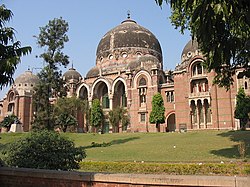Vadodara
| Vadodara | ||
|---|---|---|
|
|
||
| State : |
|
|
| State : | Gujarat | |
| District : | Vadodara | |
| Sub-district : | Vadodara | |
| Location : | 22 ° 18 ′ N , 73 ° 12 ′ E | |
| Height : | 39 m | |
|
Inhabitants : - Agglomeration : |
1,666,703 (2011) 1,817,191 (2011) |
|
| Postal code : | 390001 | |
| University building in Vadodara | ||
Vadodara ( Gujarati : વડોદરા , Vaḍodarā ; formerly Baroda ) is an important university and industrial city in western India . With around 1.7 million inhabitants (2011 census), it is the third largest city in the state of Gujarat after Ahmedabad and Surat .
geography
location
Vadodara lies at a height of approx. 35 m above sea level. d. M. on the Vishwamitri River ; it divides the city into an eastern old town area and a western modern area, which has been expanding rapidly since the British colonial era. The distance to Ahmedabad is approximately 110 km (driving distance) in a north-westerly direction; Mumbai is a good 400 km south.
climate
The early summer daytime temperatures can reach 40 ° C and more; during the monsoon season (around mid-June to mid-September) it cools down to around 30 ° C. In the winter months, the nightly lows are around 10 to 15 ° C.
History and politics
Vadodara was once the capital of the princely state of Baroda . However, Vadodara developed into a prosperous and modern city under the reign of Maharaja Sayajirao III. , which is also known as the "golden period" (1881–1939). During this time, the modernization of the economy, education and administration fell. B. the connection to the electricity network, the mechanization of factories, a comprehensive land and agrarian reform, the expansion of the regional rail network and the introduction of the prohibition of alcoholic beverages (which is still valid today and Gujarat as the only Indian state in the Indian Union to one so called "dry state"). In 1974 Baroda was officially renamed Vadodara.
In 2002, in the wake of communal riots in the state of Gujarat, Hindus and Muslims rioted violently in some mixed districts of Vadodara, killing hundreds of people, mostly Muslims. Investigations into the riots soon came to the conclusion that it was a deliberate pogrom in which the current Chief Minister Narendra Modi was involved. In May 2006 the unrest in Vadodara flared up again, but this time only a few people were killed due to the massive deployment of the military.
In 2005, the city was hit by a devastating flood, which also claimed numerous lives.
economy
Alongside Ahmedabad, Vadodara is one of the up-and-coming and rapidly expanding industrial and service centers of Gujarat . Since the economic liberalization of India in 1992, numerous foreign companies have settled in Vadodara, including some German companies. The city has a rail and motorway connection as well as an airport (daily connections to Mumbai and Delhi ), which is to be expanded into an international airport in the coming years. Vadodara is a center of the petroleum processing industry with a large refinery in the north. The industry also focuses on pharmaceutical and chemical production as well as metal processing.
education
The Maharaja Sayajirao University of Baroda (MSU) is currently the only English-speaking university in Gujarat, currently there are just over 100,000 students in 13 faculties. The Faculty of Fine Arts is one of the most renowned in India. The German course is also taught at the MSU.
religion
Vadodara is the seat of the Baroda diocese .
Attractions
Old town : Within the old town, which is surrounded by city gates, lies the Mandvi Gate at the intersection of the main axes running in north-south and east-west directions . The Nazarbaugh Palace is located in the northwest sector of the old town .
Laxmi Vilas Palace : In the years 1878–1890, the Maharaja Sayajirao III. a nested palace ensemble in the Indo-Aracen architectural style with English echoes . Indian art historians consider it one of the most magnificent Maharaja's palaces in the country. Today it contains a luxury hotel as well as a museum and a gallery. The Maharaja Fateh Singh Museum , which exhibits Japanese and Chinese art as well as Indian art , is also located on the premises . European painting is u. a. represented by works by Raffael and Murillo . These works of art were cataloged by the art historian Ernst Cohn-Wiener, who was living here in exile at the time .
Baroda Museum and Picture Gallery : Built in 1894 by Robert Fellowes Chisholm , the gallery founded there in 1910 is considered one of the best in India; In addition to numerous European artists, works by the British painter William Turner are exhibited there. The museum is located in the extensive Sayaji Bagh Park , which also houses a zoo.
Mahadev statue : In the Sursagar Talav Lake in the center of the old town, 30 meters high statue of the Hindu deity Shiva with a traditional trident.
outside
Sevasi-Baori : About 5 km west ( 22 ° 19 ′ 9 ″ N , 73 ° 7 ′ 15 ″ E ) of the city center is the Baori ( stepwell ) of Sevasi.
Approx. 45 km northeast of Vadodara ( 22 ° 27 '50 " N , 73 ° 37' 20" O ) are near the 800 m high mountain Pavagadh the archaeological largely untapped ruins of the historic town of Champaner , now a UNESCO - World Heritage Site . It was the capital of the Chauhan Rajputs from the 8th to the 15th centuries .
sons and daughters of the town
Web links
- Vadodara - Photos and brief information (English)





